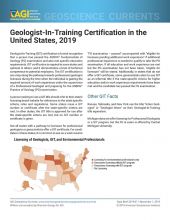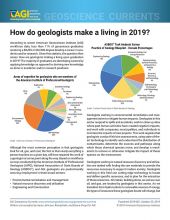A renewable and abundant source of water with its own sustainability challenges
Fresh water from underground
Groundwater is any water found underground in the cracks and pores in soil, sand, or rock. Groundwater provides 25% of the fresh water used in the United States.1 It is particularly important for irrigation and domestic uses in arid or remote areas, where surface water may be in short supply or far away. Groundwater is replenished when rainfall soaks into the ground, but it can take hundreds to thousands of years to replace what we extract. In arid areas, high demand for groundwater and slow replenishment provide challenges for sustainable groundwater management.
Fresh groundwater and total fresh water withdrawals in the U.S. over time. For most of the 20th century, water use increased to support a larger population. Much of the recent decrease in water use is due to more efficient or reduced irrigation [2].
Groundwater sustainability
Some groundwater is used and then released to surface water bodies, such as rivers or lakes, but it is almost never pumped back into the ground. Instead, groundwater is replenished almost entirely by rainfall. In the United States, roughly one quarter of all rainfall becomes groundwater.3 Groundwater makes up roughly 90% of the total available fresh water in the United States,1 but it is not evenly distributed or needed. In some areas, particularly in the more arid West, groundwater use outpaces groundwater recharge.4
Total groundwater depletions (in cubic km) for major aquifers in the contiguous U.S. from 1900-2008. Red 150-400; dark orange 50-150; light orange 25-50; dark yellow 10-25; light yellow 3-10; green 0-3; blues indicate net recharge. Image Credit: USGS
The Ogallala Aquifer
The Ogallala Aquifer is the largest aquifer in the United States. It is part of the High Plains aquifer system, which underlies parts of eight states from Texas to South Dakota. 90% of the water extracted from the Ogallala Aquifer is used for irrigation,3 supplying the water for roughly one-third of all irrigated agriculture in the country.3
Since the 1930s, massive water withdrawals have rapidly depleted the southern and central portions of the aquifer. In parts of Texas and Kansas, water levels have dropped by over 150 feet.5 The U.S. Geological Survey monitors the Ogallala Aquifer through its High Plains Water-Level Monitoring Study,6 reporting changes in water level and storage to Congress every two years. State geological surveys and other state agencies also monitor the aquifer.
Withdrawal vs. consumption
Water withdrawals only tell part of the story. Many water uses involve the borrowing of water - for thermoelectric power generation, domestic and commerical use, mining, and industry - most of which is returned to water bodies after it has been used.7 Water consumption refers to the water that is withdrawn for human use but not returned. Irrigation accounts for around 80% of fresh water consumption:7 most is lost to evaporation and the incorporation of water into crops. Although groundwater provides 25% of the fresh water used in the United States, it provides 43% of the fresh water used for irrigation.1 As a result, groundwater accounts for around 40% of U.S. fresh water consumption.
Just the numbers (2010)1
Annual fresh groundwater withdrawals
27.7 trillion gallons
Number of water wells in the United States
15.9 million
Major uses of fresh groundwater
Irrigation: 65%
Public supply: 21%
Domestic self-supply: 5%
States most dependent on groundwater (% of total fresh water withdrawals)
Kansas: 80%
Arkansas: 69%
Mississippi: 68%
Florida: 64%
Hawaii: 63%
Largest groundwater users (% of all groundwater withdrawals)
California: 16%
Arkansas: 10%
Texas: 10%
Nebraska: 6%
Idaho: 5%
96% of groundwater withdrawn is fresh; 4% is salty
98% of all self-supplied domestic water withdrawals come from groundwater wells
Key concepts, defined
Aquifer: a rock formation that contains and can transmit water
Fresh water: water with low salt concentrations (typically less than 500 parts per million)
Withdrawal: water taken from ground or surface water sources for human use. Also called “water use”
Consumption: the portion of water withdrawn that is not returned to water sources after use
More Resources
- USGS Water
- USGS High Plains Water-Level Monitoring Study
- National Ground Water Association
- 2016 AGI Critical Issues Forum - Addressing Changes in Regional Groundwater Resources: Lessons from the High Plains Aquifer
References
1 Estimated Use of Water in the United States in 2010, U.S. Geological Survey
2 Irrigated Agriculture in the United States, U.S. Department of Agriculture
3 Groundwater Facts, National Ground Water Association
4 Ground-Water Availability in the United States, U.S. Geological Survey
5 Groundwater Depletion in the United States (1900-2008), U.S. Geological Survey
6 High Plains Water-Level Monitoring Study, U.S. Geological Survey
7 Estimated Use of Water in the United States in 1995, U.S. Geological Survey

This work is licensed under a Creative Commons Attribution-NonCommercial-NoDerivatives 4.0 International License.
You are free to share or distribute this material for non-commercial purposes as long as it retains this licensing information, and attribution is given to the American Geosciences Institute.

![Fresh groundwater and total fresh water withdrawals in the U.S. over time. For most of the 20th century, water use increased to support a larger population. Much of the recent decrease in water use is due to more efficient or reduced irrigation [2] Fresh groundwater and total fresh water withdrawals in the U.S. over time. For most of the 20th century, water use increased to support a larger population. Much of the recent decrease in water use is due to more efficient or reduced irrigation [2]](https://www.americangeosciences.org/sites/default/files/Water%20use%20over%20time.png)



